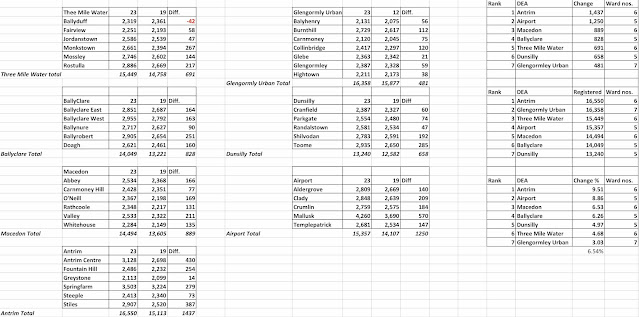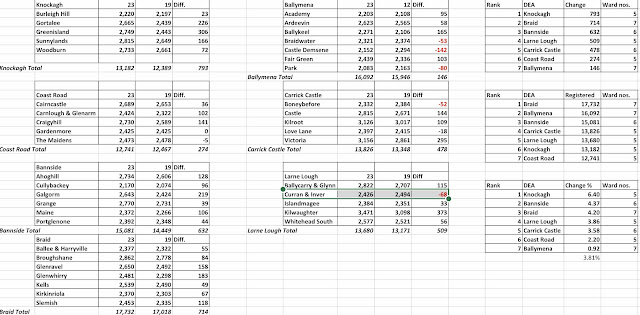Northern Ireland voter registration: by Council, DEA and Ward
The Northern Ireland Council elections are fast approaching but how much have the councils changed? For this election there are 1,372,323 registered voters, that is up 64,562 since 2019. The local government electorate is slightly different to the Parliamentary electorate.
In Northern Ireland we elect 462 councillors which corresponds to one councillor for every electoral ward. A ward is the smallest type of electoral division. There is not strict criteria on what makes up a ward in terms of population, as such we have wards ranging in size from, 5,586 voters (Lagmore) to 1,866 (Fintona). Wards are geographical areas but can change in a review to reflect population changes. It is difficult to achieve a greater parity between ward sizes, to attempt it would mean regular updates, probably more regular than our electoral boundaries are updated. I would expect that, given our population is rising, a future review will result in Northern Ireland having more councillors. The most recent review of our parliamentary boundaries has recommended splitting wards in a few instances in order to reach the tight criteria, reviewing the existing wards and creating a few more will reduce the necessity of doing this in the future.
Each ward is blocked together with other wards to create District Electoral Areas (DEAs). Each DEA consists of 5-7 wards. This somewhat offsets the large range in the size of wards but even the DEAs range from 27,006 voters in Black Mountain (a 7 seat DEA) to 11,107 voters in Erne West (a 5 seat DEA).
The largest council in Northern Ireland is, by far, Belfast, with 235,651 registered voters. Belfast also elects 60 councillors while the other councils only elect 40 or 41. Belfast does also have the largest average ward size with an average of 3,928 voters per ward, the next largest has 3,772 voters per ward. Fermanagh and Omagh is the smallest Council with just 86,806 registered voters and an average of just 2,170 voters per ward. Interestingly the smallest ward in Belfast is Merok with 3,267 registered voters, this makes it larger than the average ward size in every council except Belfast and, Armagh, Banbridge and Craigavon.

Belfast has also added the most voters since 2019 with a net gain of 10,688 voters, however Lisburn and Castlereagh has been the council with the largest proportional growth. It has added 7,095 voters which is up 6.93% since 2019. Fermanagh and Omagh has added the fewest new voters, up just 2,339 or 2.77%.
Some wards have seen huge changes, Skeoge (Derry and Strabane) has added 859 voters, an increase of 26.37%. You can see the top 15 wards by growth below.
There are also 37 wards that have fewer registered voters than in 2019. Killycomain in Portadown has lost 219 voters, a decrease of 6.6%. Cathedral in Armagh and Windsor in Botanic has each lost a single voter. Derry and Strabane contains 8 wards that are smaller than in 2019.

DEA changes
The DEA with the largest increase in registered voters is Oldpark in Belfast, adding 1,647 voters. The DEA with the largest percentage growth is Kilultagh in Lisburn and Castlereagh, up 9.7% just ahead of Antrim Centre which is up 9.51%. You can see the top 15 of each below.

Erne East has a net gain of just 9 registered voters, up 0.07%. Foyleside is the only other DEA to add fewer than 100 voters, adding just 25 and growing by 0.19%. You can see the DEAs with the smallest growth below.

Registered voters by council area:
Antrim & Newtownabbey:
The largest DEA is Antrim with 16,550 registered voters, it is also the DEA with the largest increase adding 1,437 voters (9.51%). The Antrim centre ward has added 430 voters while Greystone has only added 14 voters.
The smallest DEA is Dunsilly, 13,240 and the DEA with the least growth is actually the 7 seat Glengormley Urban, adding just 481 voters (3.03%).

Ards & North Down
The largest DEA is Newtownards, 21,555 and the largest growing DEA is Ards Peninsula, up 1,240 (7.03%).
The smallest DEA is Bangor West, 14,416 and the worst growing DEA is Bangor East, up 474 (2.71%).

Armagh, Banbridge & Craigavon
The largest DEA is Lurgan, 26,652 and the largest growing DEA is Craigavon, up 1,377 (7.28%).
The smallest DEA is Lagan River, 18,276 and the worst growing DEA is Portadown, up 391 (1.79%).

Belfast
The largest DEA is Black Mountain, 27,006 (largest in Northern Ireland) and the largest growing DEA is Oldpark , up 1,647 (7.46%).
The smallest DEA is Balmoral, 18,607 and the worst growing DEA is Ormiston, up 391 (2.18%).

Causeway Coast & Glens
The largest DEA is Ballymoney, 18,031 and the largest growing DEA is Coleraine , up 839 (4.99%).
The smallest DEA is Limavady, 11,565 which is also the worst growing DEA, up 322 (2.86%).
Derry & Strabane
The largest DEA is Waterside, 21,115 and the largest growing DEA is Ballyarnett, up 1,477 (8.42%).
The smallest DEA is Foyleside, 13,313 which is also the worst growing DEA, up 25 (0.19%).
Fermanagh & Omagh
The largest DEA is Enniskillen, 13,563 which is also the largest growing DEA, up 461 (3.82%)
The smallest DEA is Erne West, 11,107 (smallest in Northern Ireland) which is also the worst growing DEA, up 9 (0.07%).
Lisburn & Castlereagh
The largest DEA is Castlereagh South, 18,031 and the largest growing DEA is Kilultagh, up 1,403 (9.7%).
The smallest DEA is Downshire East, 12,680 which is also the worst growing DEA, up 432 (3.53%)
Mid & East Antrim
The largest DEA is Braid, 17,732 and the largest growing DEA is Knockagh , up 793 (6.4%).
The smallest DEA is Coast Road, 12,741 and the worst growing DEA is Ballymena, up 146 (0.92%).
Mid Ulster
The largest DEA is Cookstown, 17,055 and the largest growing DEA is Clogher Valley, up 847 (5.7%).
The smallest DEA is Carntogher, 12,632 which is also the worst growing DEA, up 266 (2.15%)
Newry, Mourne & Down
The largest DEA is Slieve Gullion, 22,532, which is also the largest growing DEA, up 1,576 (7.52%).
The smallest DEA is Downpatrick, 15,579 and the worst growing DEA is Newry, up 339 (1.74%).
There is no obvious correlation between those areas adding more registered voters and those adding the fewest. Anecdotally I have noticed plenty of house building in Antrim and Newtownabbey, especially around Antrim town where I have worked in the last few years, and so I am not surprised to see large growth in this area. Lisburn and Castlereagh has made headlines with complaints about building projects and again, anecdotally, a work colleague has been telling me of the huge growth in housing in Ballymacoss. I can only assume that those areas that are experiencing the most growth are also those building the most new homes.
Population changes can have a knock on effect in elections. There are only 2 Unionist candidates standing in the Airport DEA with suggestions that there have been significant demographic changes in the area. I have heard of people moving from west Belfast into parts of Lisburn so it may be worth keeping an eye on the nationalist, particularly the Sinn Féin, vote in Lisburn North and Lisburn South, however we are just a year out from them last Assembly election and there was no significant rise in the nationalist vote, in fact nationalism lost a seat in Lagan Valley.
There are small unionist or nationalist areas all over Northern Ireland. Nationalism has one seat in Ards and North Down, and, coincidentally that seat is in the DEA with the most growth in the area, Ards Peninsula. There is no area that stands out as being significantly better or worse than the others with the largest growth coming in one of the already large wards and the least growth coming in the smallest. It might also be tempting to try to isolate voter registration figures to see how Sinn Féin may fair in the Titanic DEA. Sinn Féin won here in 2014 and lost in 2019 on similar vote shares. The bulk of the Sinn Féin vote comes from Short Strand in the Ballymacarrett ward, however it does not make up the entire ward and again, no single ward has any stand out growth compared to another. Interestingly there are no Unionist candidates in Collin this year. Unionism won around 400 votes last time around and so there are unionist votes up for grabs, it is impossible to say how many more or less than in 2019 however. I am sure people with more data than I have access to can shed more light on these speculations, but either way, we shall see what happens in just a few weeks.
Ultimately this is deep analysis that may provide little or no value when trying to predict where seats may be won in an election, but I know some people will find it interesting and perhaps this can be useful for other purposes.
I had intended to write about some issues leading up to this election but I have been a lot busier with work than I had anticipated. I laid this basis for this piece back in November so I prioritised work on this. I will be back with some analysis of results after the election. For a daring prediction of results see the previous post.










Comments
Post a Comment